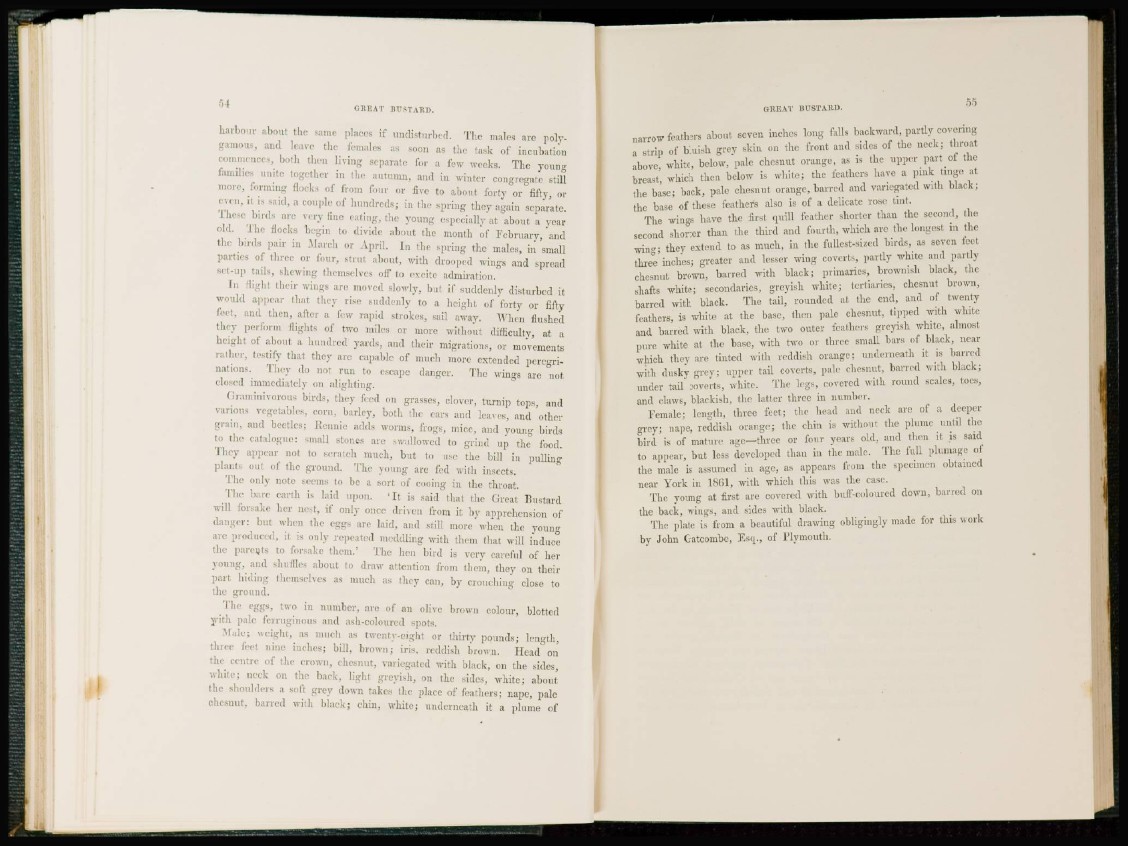
54 GREAT BUSTARD.
harbour about the same places if undisturbed. The males arc polygamous,
and leave the females as soon as the task of incubation
commences, both then living separate for a few weeks. The young
families mute together in the autumn, and in winter congregate still
more, forming flocks of from four or five to about forty or fifty, or
even, it is said, a couple of hundreds; in the spring they again separate.
These birds arc very tine eating, the young especially at about a year
old. The flocks begin to divide about the month of February, and
t h e birds pair in March or April. In the spring the males, in small
parties of three or four, strut about, with drooped wings and spread
set-up tails, shewing themselves off to excite admiration.
I n (light their wings are moved slowly, but if suddenly disturbed it
would appear that they rise suddenly to a height of forty or fifty
feet, and then, after a few rapid strokes, sail away. When flushed
they perform flights of two miles or more without difficulty, at a
height of about a hundred yards, and their migrations, or movements
rather, testify that they are capable of much more extended peregrinations.
They do not run to escape danger. The wings are not
closed immediately on alighting.
Graminivorous birds, they feed on grasses, clover, turnip tops, and
various vegetables, corn, barley, both the cars and leaves, and other
grain, and beetles; Bonnie adds worms, frogs, mice, and young birds
to the catalogue: small stones are swallowed to grind up the food.
They appear not to scratch much, but to use the bill in pulling
plant" out of the ground. The young are fed with insects.
The only note seems to be a sort of cooing in the throat.
The bare earth is laid upon. 'It is said that the Great Bustard
will forsake her nest, if only once driven from it by apprehension of
danger: but when the eggs are laid, and still more when the young
are produced, it is only repeated meddling with them that will induce
the parents to forsake (110111.' The hen bird is very careful of her
young, and shuffles about to draw attention from them, they on their
part hiding themselves as much as they can, b)r crouching- close to
the ground.
The eggs, two in number, are of an olive brown colour, blotted
with pale ferruginous and ash-coloured spots.
Male; weight, as much as twenty-eight or thirty pounds; length,
t h r e e feet nine inches; bill, brown; iris, reddish brown. Head on
the centre of t h e crown, chesnut, variegated with black, on the sides,
white; neck on the back, light greyish, on the sides, white; about
the shoulders a soft grey down takes the place of feathers; nape, pale
chesnut, barred with black; chin, white; underneath it a plume of
G R E A T n v S T A R D. 55
narrow feathers about seven inches long falls backward, partly covering
a strip of bluish grey skin on the front and sides of the neck; throat
above, white, below, pale chesnut orange, as is the upper part of the
breast, which then below is white; the feathers have a pink tinge at
the base; back, pale chesnut orange, barred and variegated with black;
the base of these feathers also is of a delicate rose tint.
The wings have the first quill feather shorter than the second, the
second shorter than the third and fourth, which arc the longest in the
wing; they extend to as much, in the fullest-sized birds, as seven feet
three inches; greater and lesser wing coverts, partly white and partly
chesnut brown, barred with black; primaries, brownish black, the
shafts white; secondaries, greyish white; tertiaries, chesnut brown,
barred with black. The tail, rounded at the end, and of twenty
feathers, is white at the base, then pale chesnut, tipped with wdiite
and barred with black, the two outer feathers greyish white, almost
pure white at the base, with two or three small bars of black, near
which they are tinted with reddish orange; underneath it is barred
with dusky grey; upper tail coverts, pale chesnut, barred with black;
under tad coverts, white. The legs, covered with round scales, toes,
and claws, blackish, the latter three in number.
Female; length, three feet; the head and neck are of a deeper
grey; nape, reddish orange; the chin is without the plume until the
b i r d is of mature age—three or four years old, and then it is said
to appear, but less developed than in the male. The full plumage of
the male is assumed in age, as appears from the specimen obtained
near York in 1861, with which this was the case.
The young at first are covered with bufl-coloured down, barred on
the back, wings, and sides with black.
The plate is from a beautiful drawing obligingly made for this work
by John Gatcombe, Esq., of Plymouth.